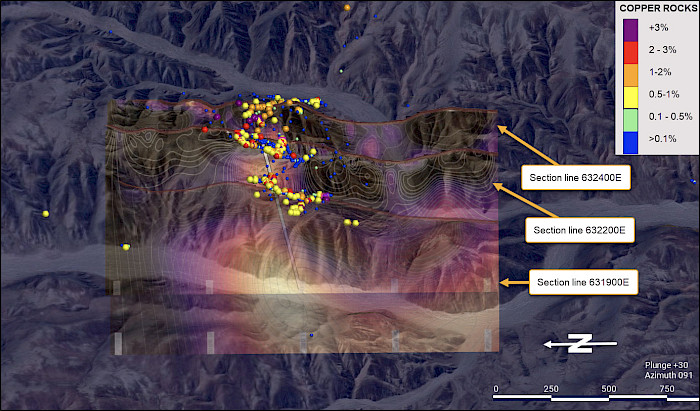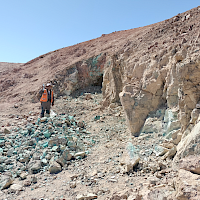Tierra Roja Copper Project - Peru
-
Tierra Roja Copper Project – Peru
Radius Gold Inc. holds an option to acquire the Tierra Roja Copper Project, a large-scale, highly prospective copper system located in the Arequipa region of southern Peru. Radius has secured the rights to a total of 8,170 hectares, including 3,670 hectares at the core Tierra Roja target and an additional 4,500 hectares across three regional properties currently under exclusivity agreements for evaluation and potential future optioning.
Overview:
Tierra Roja has intense silica-serricite alteration and abundant outcropping copper oxide mineralization, exposed over an 800m x 600m area, with compelling targets for exploration and discovery. The site is easily accessible and a low-cost exploration target located in a world-class-copper producing district. Key Highlights include:
Key Highlights
-
District Location: Tierra Roja is located in Peru’s southern coastal porphyry belt, 20 km from the Pan American highway in one of the world’s most productive copper districts.
-
New early-stage discovery: No prior systematic exploration or drilling
-
Surface Mineralization: Intense silica-serricite alteration and abundant outcropping copper oxide mineralization, exposed over an 800m x 600m area indicating compelling targets for exploration and discovery
-
Prospecting continuous rock chip samples grade 1.25% Cu over 35m, and 2.1% Cu over 20m.
-
Geophysics: Recently completed IP resistivity survey define a large coherent zone of high resistive and high chargeable material at depth below the copper mineralization, indicating drill targets.
-
Permitted: Drill permits granted, Environmental, archaeological, and ecological surveys completed; drilling is expected in Q3 2025.
-
Access and infrastructure: Road accessible, arid terrain. Radius is in negotiations for a new access road, connecting to the Pan American Highway.
Staged option payments tied to exploration success.
Location
The Tierra Roja is in the coastal desert of southern Peru, at an elevation of 1700 meters above sea level, and 20km from the Pan American highway. The project site is accessible by road and 4x4 tracks. Tierra Roja is located at the northern end of the southern Peru coastal copper belt which hosts some of the largest copper mines in the world. Peru is the second largest copper producer globally.
Figure 1. Tierra Roja project location, at the northern end of the southern Peru porphyry copper belt:
Discovery
Tierra Roja project covers 3,670 hectares, where the core of the property hosts an 800 meter diameter circular anomaly with wide-spread ferruginous, sulphate soil crust developed over strong clay, sericite and silica alteration. In arid climates sulphate crusts can indicate underlying copper mineralization. The presence suggests that sulfide oxidation and leaching have occurred, which may point to deeper copper enrichment zones.
The rusty clay sulphate crust present at Tierra Roja is a few meters thick and largely hides the underlying copper oxide mineralization. The property optionor, Mr. Montoya, a Peruvian geologist with over 50 years field experience, including senior positions with copper companies: Asarco Inc (Central America, Chile), Lowell Mineral Exploration (Chile, Peru), TVX Gold (Peru, Mexico) and Minsur (Peru), recognized the remote colour anomaly and the significance of the sulphate crust and staked the project. Mr. Montoya cut road access with a bulldozer, breaking the ferruginous sulphate crust, and exposing widespread oxide copper mineralization covering an area of 800m x 600m.
Figure 2. Tierra Roja project, copper oxides mineralization exposed below thin ferruginous sulphate soil cover:
663 original rock chip channels (2 to 3m) were sampled by Mr. Montoya from the road cuts, tracks and drainages. As part of Radius’s due-diligence, 50 duplicates and control samples were collected. These 713 samples define a large-scale copper system hosted in a multiphase intrusive complex.
Figure 3. Tierra Roja project copper geochemistry, showing widespread and high-grade copper in rock chip channel sampling:
Copper mineralization occurs as copper oxides, predominately malachite, chrysocolla and brochantite, both disseminated within the intrusives and concentrated in wide structural zones. High grades above 3% copper (max 12.5%) have been sampled at multiple locations over the property (Figure 3). Relict sulphide halos indicate that the intrusive host is the likely source of the copper mineralization which has been leached, oxidized and remobilized.
Geology
Figure 4. Tierra Roja detailed alteration mapping with copper grades over 1% depicted.
Alteration Zonation
Several zones of structurally controlled EW oriented zones intense silica, sericite dominant alteration between 50 to 150m wide are associated with copper mineralisation. Higher grade (+3% Cu) are often completely brecciated and replaced by silica. The larger zones of intense alteration are surrounded by wide zones of moderate to weak alteration and then relatively fresh rock. The outer margins of the system have chlorite epidote alteration. Mineralization occurs as copper oxides, dominantly malachite, chrysocolla, and atacamite hosted with structures and broadly disseminated. The host rocks regionally are andesitic volcanics of upper Cretaceous / lower Tertiary age. The core of the target is comprised of a multi-phase intrusive complex dominantly of dacite composition, but also andesite and quartz-feldspar porphyry. There is widespread faulting, brecciation and complete replacement of large areas (50 to 150m wide) by silica sericite alteration.
The origins of the intense alteration and copper oxide mineralization observed at surface are uncertain. Drilling is required. There has been some debate amongst our experienced Peruvian team and several visitors to the project as to whether the observed characteristics are related to porphyry copper or IOCG mineralisation. Tierra Roja lies 120km south of the large IOCG deposits Mina Justa, Marcona, Pampa de Pongo and further north Mina Raul Contestable. 200km south of Tierra Roja occur very large porphyry copper deposits in La Tapada, Tia Maria, Cerro Verde, Chapi etc.
Tierra Roja has a significant scale alteration system, abundant copper oxide mineralisation occurring over a large area, a strong co-incident IP - chargeable and resistivity anomaly extending to depth below the outcropping alteration and mineralization and has never been drill tested. Radius team looks forward to drilling this compelling target.
Figure 5. Intrusive, leached, intense silicified, clay sericite altered and veined:
Figure 6. High grade 6% copper oxides as malachite, chrysocolla, and brochantite in silicified intrusive:
Access and Permitting
Tierra Roja is located on federal land, 20km from the coast and the Pan American Highway. Topography is low rolling hills, accessible by pre-existing tracks. The climate is arid and there are no residents, artisanal miners, or registered communities located on the property. Radius has received permits for drilling. The field component of environmental surveys, flora, fauna and archaeological studies have been completed.
Work Completed
There has been no drilling or significant exploration previously conducted at Tierra Roja. Radius completed a 67 line km ground magnetic survey of the core Tierra Roja claims,. Radius has also completed detailed geological mapping of lithology and hydrothermal alteration, forming the basis for a broader regional exploration initiative. To rapidly assess its expanded land position, Radius also completed an AI-driven hyperspectral remote sensing survey, integrating data from multiple satellite platforms (see Figures 7 to 9 below).
In parallel, Radius has completed a detailed geochemical sampling grid at Tierra Roja, utilizing low-detection-limit assays for 49 elements (assay results pending). Historical sampling at Tierra Roja was limited to mostly copper and this new dataset will assist in geochemical zonation, refine drill targets, and serve as a reference tool as Radius evaluates its broader regional portfolio.
The integrated approach has enhanced Radius’s understanding of mineralization at Tierra Roja, expanded known targets, and generated new regional targets for evaluation and potential acquisition.
To support drill targeting, Radius has also recently completed induced polarization (IP) and resistivity geophysical surveys. The combination of significant surface copper oxide copper mineralisation, hosted in highly altered (silica, sericite) intrusive and volcanics, with a large resistive and chargeable geophysics response at depth define compelling drill targets. The Radius geological team will lead the project with local input and support from geological and operational staff provided by our project partners.
Figure 7. PRISMA satellite, ASTER641 equivalent image draped over 3D topography, highlights in green circular strong clay alteration, around the core of the Tierra Roja copper target. Note the area to the NE is covered by post mineral gravel, masking the area.
Figure 8. Fused ASTER/Sentinel-2 product, Ferric oxide composition image draped over 3D topography, highlights in yellow-orange iron oxides, at Tierra Roja copper target.
Figure 9. Fused ASTER/Sentinel-2 product, Alteration (hydrothermal minerals) heat map draped over 3D topography. Highlights a circular anomaly bordering the core Tierra Roja copper target. The core of the system identified by high grade rock chip copper sampling is strongly silicified (field mapping) and corresponds to a lower spectral signature in the views depicted.
About the IP/Resistivity Survey
The IP/Resistivity consisted of 3 NS orientated lines, total 4.8km surveyed covering the core 800m diameter system. Initial interpretation indicates a broad and coincident resistivity and chargeable anomaly dipping south to depth from the main out cropping copper oxide mineralised zones. The geophysical chargeable and resistive anomaly is consistent line to line across 500m of tested strike extension.
Figure 10: IP/Resistivity plan view at 1500masl (approximately 250m below surface) with 2D IP and Resistivity cross-sections of central line 632200E. Note almost co-incident chargeable and resistive anomalies. Chargable anomaly is approximately 3X greater than background and is consistent line to line across 500m. Proposed drill hole depicted.
Figure 11: IP 3D Inversion on central line 632200E showing chargeable anomaly 3 times background levels, below copper mineralisation at surface. Proposed drill hole depicted.

Figure 12: 3D Chargability view looking east at Tierra Roja with transparent topography and rock chip geochemistry, showing relative position of three lines and consistency of chargeable anomaly across 500m.
Tierra Roja has a significant scale alteration system, abundant copper oxide mineralisation occurring over a large area, a strong co-incident IP - chargeable and resistivity anomaly extending to depth below the outcropping alteration and mineralization and has never been drill tested. The Radius team looks forward to drilling this compelling target.
Drill Permits
Radius local subsidiary in Peru has been granted FTA (Ficha Técnica Ambiental) authorizations that approves drilling and the construction of 20 drill pads and access roads. From each platform several drillholes can be completed. The FTA also covers land access and in the case of Tierra Roja, the land is federally owned with no registered occupants and access approved. There is no drilling water available on-site and water will need to be purchased and trucked in from an approved mining supply of which there are several available sources within the district. The alternative for drilling without water is RC (reverse circulation). Radius is currently negotiating drill contracts with potential suppliers.
Quality Assurance and Quality Control
Copper geochemistry consists of 663 rock chip channel samples, collected by a Peruvian mining company and analyzed in a mine laboratory that is not internationally certified. All samples were 2 to 3m chip channels clearly marked with sample numbers. Radius commissioned a senior Peruvian geologist to take 40 duplicate control samples, which were checked in the field by Radius CEO and QP Bruce Smith, who collected an additional 10 duplicates. The 50 control samples, with standards and blanks, were assayed by internationally certified laboratory Certimin S.A. The results of the visual inspections in the field (with visible copper oxides) and combined assays from the 50 control samples confirm the validity of the original samples. There were no significant discrepancies between duplicates. The copper analysis for the 663 original samples is deemed reliable and fit for the purpose of exploration.
-














